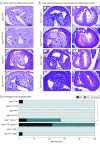Novel Association of the NOTCH Pathway Regulator MIB1 Gene With the Development of Bicuspid Aortic Valve
- PMID: 37405741
- PMCID: PMC10323766
- DOI: 10.1001/jamacardio.2023.1469
Novel Association of the NOTCH Pathway Regulator MIB1 Gene With the Development of Bicuspid Aortic Valve
Abstract
Importance: Nonsyndromic bicuspid aortic valve (nsBAV) is the most common congenital heart valve malformation. BAV has a heritable component, yet only a few causative genes have been identified; understanding BAV genetics is a key point in developing personalized medicine.
Objective: To identify a new gene for nsBAV.
Design, setting, and participants: This was a comprehensive, multicenter, genetic association study based on candidate gene prioritization in a familial cohort followed by rare and common association studies in replication cohorts. Further validation was done using in vivo mice models. Study data were analyzed from October 2019 to October 2022. Three cohorts of patients with BAV were included in the study: (1) the discovery cohort was a large cohort of inherited cases from 29 pedigrees of French and Israeli origin; (2) the replication cohort 1 for rare variants included unrelated sporadic cases from various European ancestries; and (3) replication cohort 2 was a second validation cohort for common variants in unrelated sporadic cases from Europe and the US.
Main outcomes and measures: To identify a candidate gene for nsBAV through analysis of familial cases exome sequencing and gene prioritization tools. Replication cohort 1 was searched for rare and predicted deleterious variants and genetic association. Replication cohort 2 was used to investigate the association of common variants with BAV.
Results: A total of 938 patients with BAV were included in this study: 69 (7.4%) in the discovery cohort, 417 (44.5%) in replication cohort 1, and 452 (48.2%) in replication cohort 2. A novel human nsBAV gene, MINDBOMB1 homologue MIB1, was identified. MINDBOMB1 homologue (MIB1) is an E3-ubiquitin ligase essential for NOTCH-signal activation during heart development. In approximately 2% of nsBAV index cases from the discovery and replication 1 cohorts, rare MIB1 variants were detected, predicted to be damaging, and were significantly enriched compared with population-based controls (2% cases vs 0.9% controls; P = .03). In replication cohort 2, MIB1 risk haplotypes significantly associated with nsBAV were identified (permutation test, 1000 repeats; P = .02). Two genetically modified mice models carrying Mib1 variants identified in our cohort showed BAV on a NOTCH1-sensitized genetic background.
Conclusions and relevance: This genetic association study identified the MIB1 gene as associated with nsBAV. This underscores the crucial role of the NOTCH pathway in the pathophysiology of BAV and its potential as a target for future diagnostic and therapeutic intervention.
Conflict of interest statement
Figures




References
Publication types
MeSH terms
Substances
Grants and funding
LinkOut - more resources
Full Text Sources
Molecular Biology Databases

